I’m not a fan of online ‘city vs city’ threads. They can be brutal exchanges where the reader won’t get much hard information about the cities in the comparison battle. They’d get a bunch of opinions about the quality of life, how many amenities this city has over that city. I’d have to admit that I find it fascinating how the data of the compared cities can be skewed by overzealous residents/supporters. The idea to compare Charlotte and Atlanta was born out of driving through Charlotte on the way back from a sci-fi, fantasy and comics convention held in High Point, NC. I was impressed with Charlotte’s skyline, the bustling central business district (they call it uptown), the light rail system and all the new housing and office construction. I’d heard many people refer to Charlotte as ‘baby Atlanta’, I secretly wondered just how close our baby sister city had come to Atlanta.
Charlotte is similar to Atlanta, right?
Growing up, I visited Charlotte a lot and looked at the city as the North Carolina version of Atlanta. After all, it had a Six Flags-like amusement park, only smaller (Carowinds). It had a relatively impressive skyline and interstate 85. This comparison was shattered when I moved to Atlanta to attend college. I found Atlanta much larger, more cosmopolitan, it has a freaking subway and a faster bustle. The cities have competed for many years for Fortune 500 headquarters, and a NASCAR Hall of Fame. Charlotte has been a major banking center for decades, and Atlanta, dubbed ‘Hollywood of the South,’ has been one of the top places to film movies and television shows.
This is not a complete city comparison. You won’t find quality of life metrics such as ‘best neighborhoods based on these amenities’ rankings, the number of museums, entertainment facilities or how the parks compare. The scope of this article is to compare population, density, size in square mileage, public transit size and ridership, the number of tall buildings, median household income, and poverty. These are the base attributes that most would agree define a city.
Population & Income
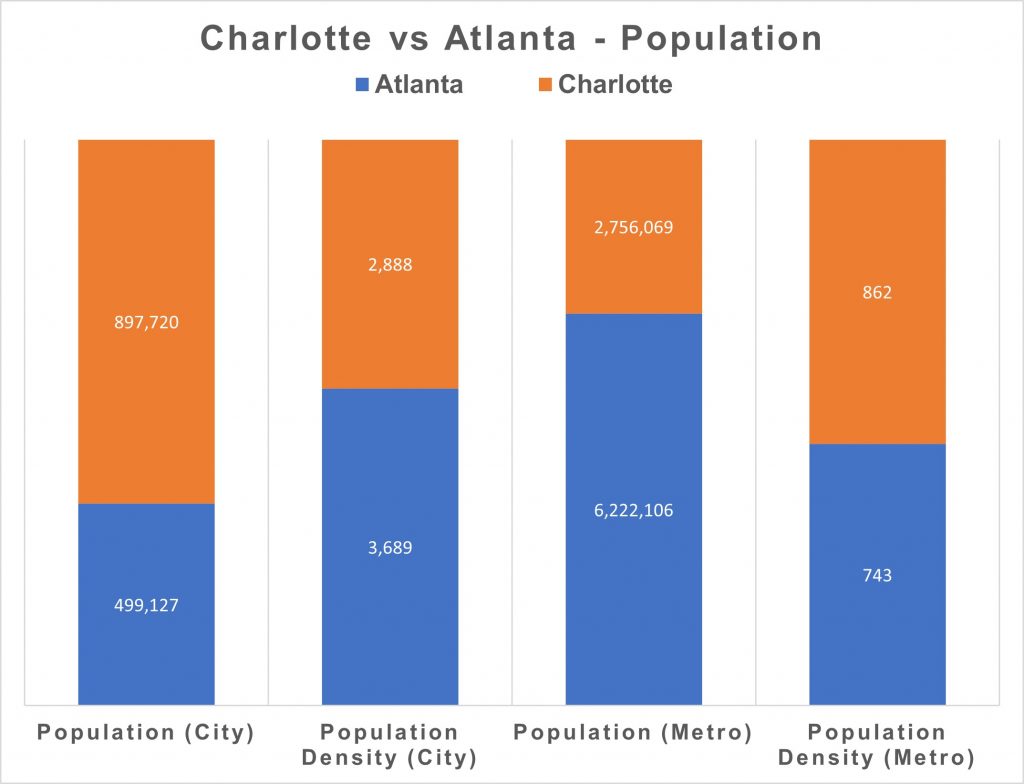
Data from U.S. Census Bureau
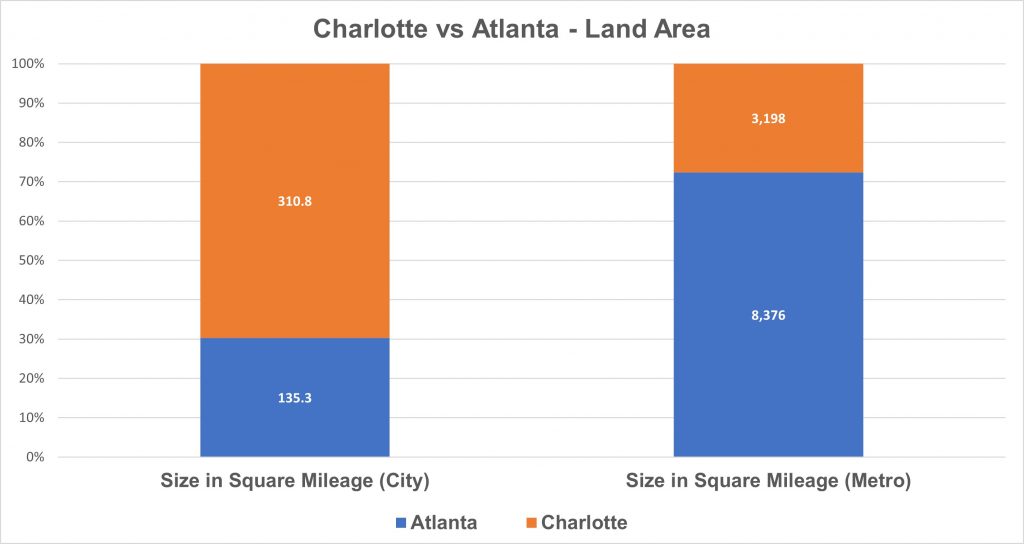
Data from U.S. Census Bureau
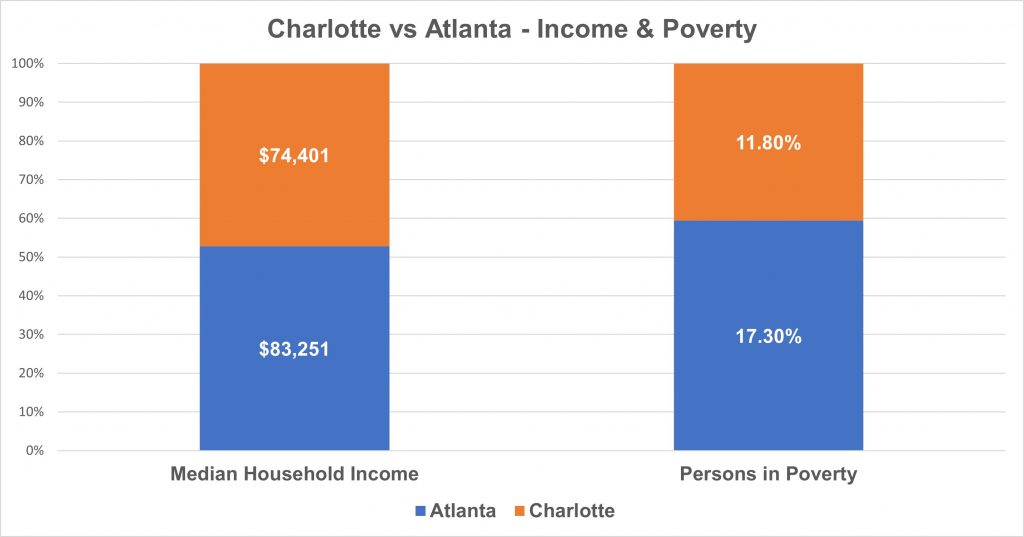
Data from U.S. Census Bureau
| Atlanta | Charlotte | How Charlotte compares to Atlanta | |
| Population (City) (est. 2022) | 499,127 | 897,720 | City of Charlotte is 1.8 times larger in population than city of Atlanta |
| Population Density (City) | 3,689 | 2,888 | City of Charlotte is 1.3 times less dense than city of Atlanta |
| Population (Metro) | 6,222,106 | 2,756,069 | Metro Charlotte is 2.3 times smaller in population than metro Atlanta |
| Population Density (Metro) | 743 | 862 | Metro Charlotte is 1.13 times more dense than metro Atlanta |
| Size in Square Mileage (City) | 135.3 | 310.8 | City of Charlotte’s land area is 2.30 times bigger than city of Atlanta’s land area |
| Size in Square Mileage (Metro) | 8,376 | 3,198 | Metro Charlotte’s land area is 2.62 times smaller than metro Atlanta’s land area |
| Median Household Income | $83,251 | $74,401 | The median household income in the city of Charlotte is 11% lower than the median household income in the city of Atlanta |
| Persons in Poverty | 17.30% | 11.80% | City of Charlotte’s percentage of person’s in poverty is 32% lower than the city of Atlanta’s percentage of persons in poverty |
Data from U.S. Census Bureau
Charlotte boosters can technically say Charlotte is BIGGER than Atlanta in population and size. In fact, the city of Charlotte is 1.75 times larger than the city of Atlanta in population and more than double the size of Atlanta as measured in square miles. There are asterisks though. The first one, Charlotte’s city population is the result of it gobbling up land through annexations over the past two decades. Charlotte’s footprint is almost 175 square miles larger than city of Atlanta’s footprint. If the city of Atlanta were to annex all of unincorporated Dekalb County, which is roughly 150+ square miles. The city of Charlotte would still have about 25 square miles more than Atlanta.
The other asterisk is Atlanta’s metro area is more than twice as large as Charlotte’s metro area. The census defines a metropolitan area as counties of a region where the majority of the working population commutes into the center city. This is a more reliable indicator of dominance than city population alone.
The cities couldn’t be more different in density. The city of Atlanta has almost 1,000 more people per square mile than Charlotte, or 1.3 times more densely populated. I was struck by the Charlotte City Limits sign when we were driving on U.S. 29. The landscape didn’t change it was very rural looking. Metro Atlanta is less dense than metro Charlotte, a respective 710 persons per square mile compared to 803 persons per square mile. With metro Atlanta gobbling much of northern Georgia, consisting of 30 counties, covering an area roughly the size of Massachusetts, it’s not hard to see why Atlanta remains a sprawling monster.
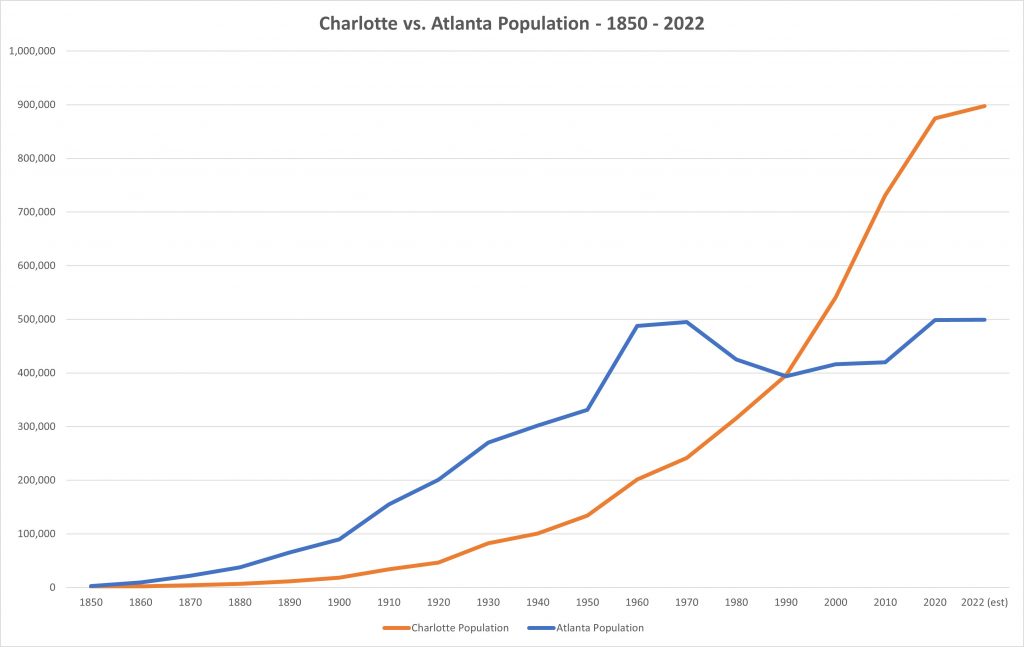
Data from U.S. Census Bureau
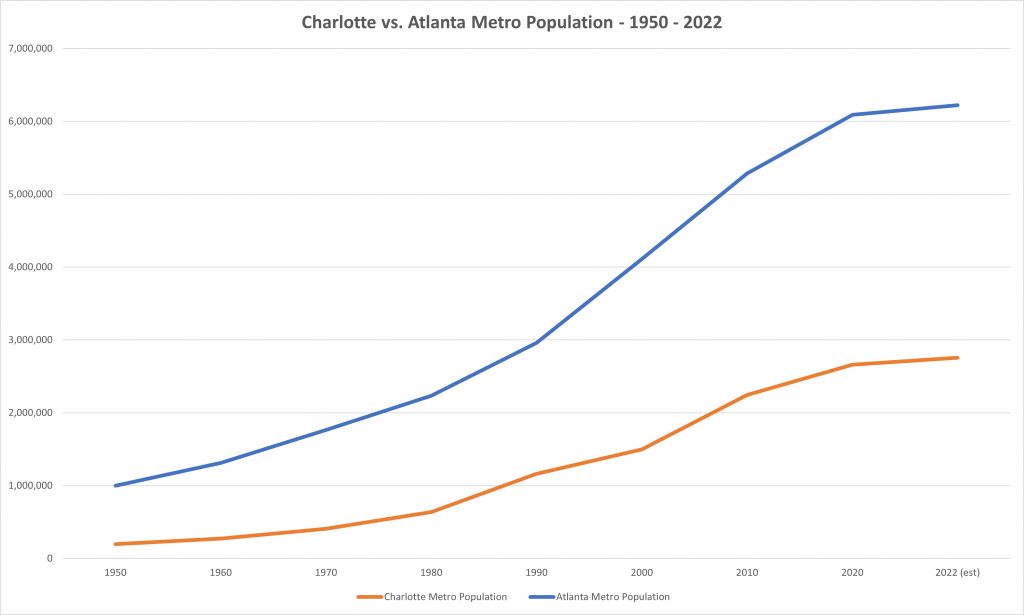
Data from U.S. Census Bureau
Map of Charlotte Sprawl
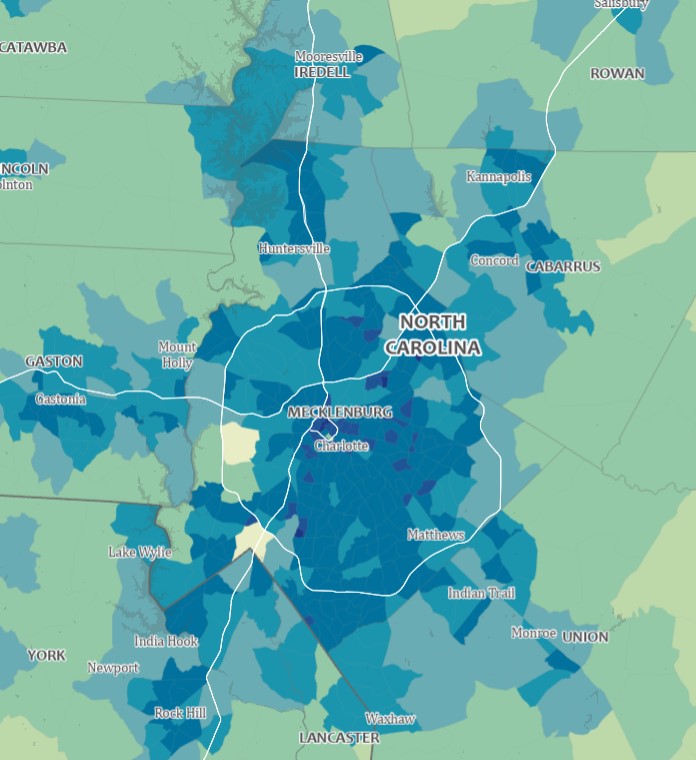
U.S. Census Bureau
Map of Atlanta Sprawl
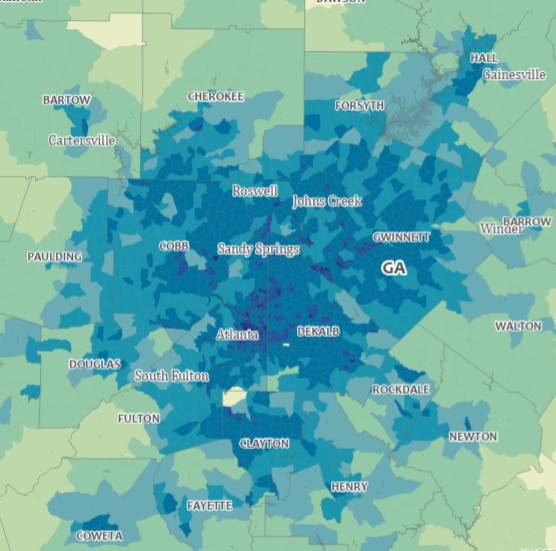
U.S. Census Bureau
Note: Maps are not to scale
Public Trains and Buses: How Does Charlotte’s Transit System Stack up to Atlanta’s?
So, how does Charlotte’s public transit compare with Atlanta’s? Charlotte Area Transit System (CATS), the rebranded Charlotte Transit, became official in 1999. The system has seen growth since then, with the recent introduction of light rail and streetcars. Today, CATS carry over 34,630 riders each day (buses, light rail, and streetcar), in a system with 43 stations, on 22.6 miles of rail.
In 1979, the Metropolitan Atlanta Rapid Transit Authority (MARTA) opened heavy rail transit service in Atlanta, giving Atlanta the distinction of being the first city in the deep south to get such service. In 2020, MARTA was the 10th largest transit system (counting all modes of transportation) in North America, based on the number of unlinked trips. Its heavy rail system was the 7th largest in North America based on the number of unlinked trips. Today, MARTA carries 140,904 riders every day (bus, heavy rail and streetcar combined), on 48 miles of rail, with 50 stations.
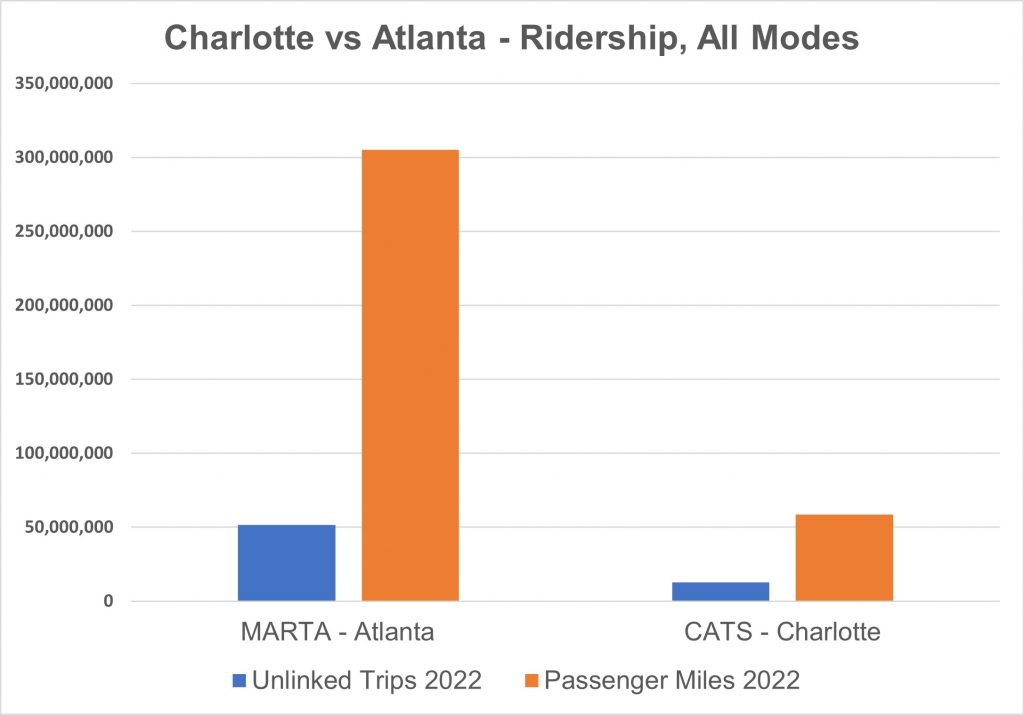
Data from American Public Transportation Association
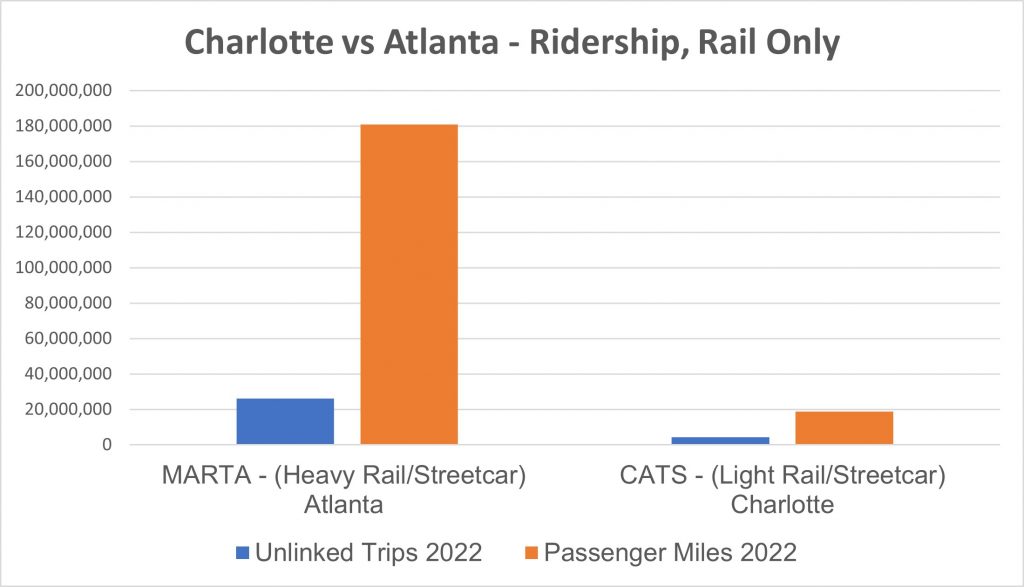
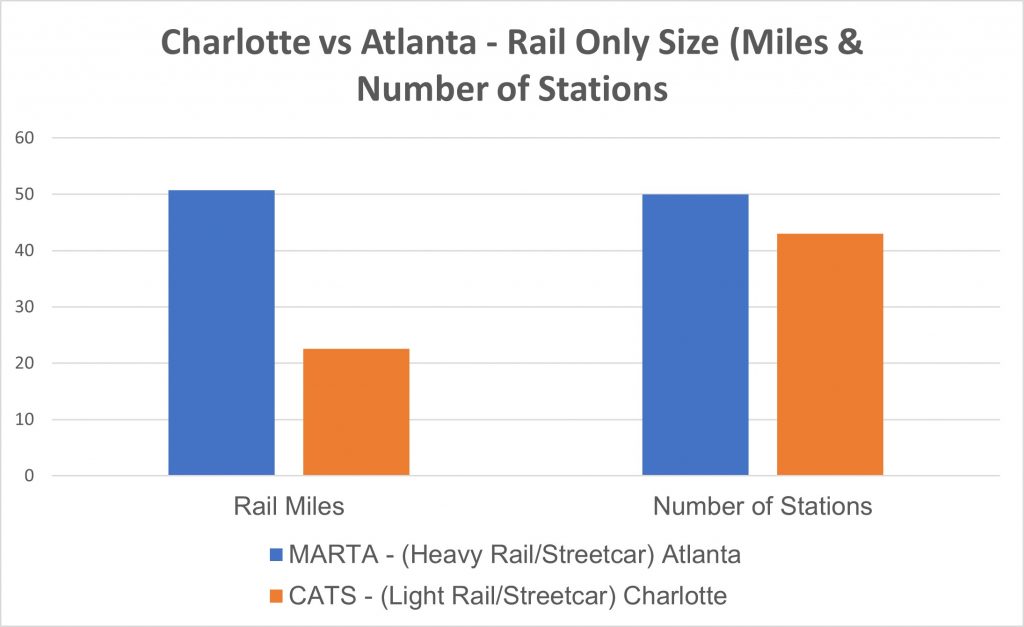
Data from American Public Transportation Association
Buildings Going Up Everywhere: How Does Charlotte’s Skyline Compare to Atlanta’s?
Skyscrapers and city skylines have been a fascination of mine since my first trip to New York City as a small child. Seeing stacks of buildings in Manhattan made an indelible impression and set up my love affair for architecture and city planning. In comparing Charlotte and Atlanta, the number of skyscrapers, skyscraper density and top five tallest will be compared.
The Charlotte skyline has really expanded over the past decade, with gleaming high-rise condos and office buildings sprouting out of the ground like trees. Charlotte’s skyline, while greatly expanded, is still pretty much limited to staying within the uptown area. It makes a great showing when driving on I-277.
Atlanta’s skyline has greatly expanded (and it’s still going) in the last few decades. Growing up, I’d been to Charlotte many more times than Atlanta. I remember thinking as a teenager that Charlotte’s and Atlanta’s skylines were roughly the same in size. Truth set in when I came to Atlanta to attend college. I felt not only Atlanta had way more tall buildings, but it just felt much bigger. The vibe, the pace was electric. I remember feeling like I wasn’t in Georgia, even after nearly a year of living in Atlanta. Let’s see how Charlotte and Atlanta compare in the skyline department.
According to Skyscraperpage.com, Atlanta ranked 51 globally in the number of high-rises, with 357 (considered as buildings 12 floors and higher or 115 feet and higher). Charlotte ranked at 150, with 100 high-rises. These numbers include the high-rises in all sub-markets in each city.
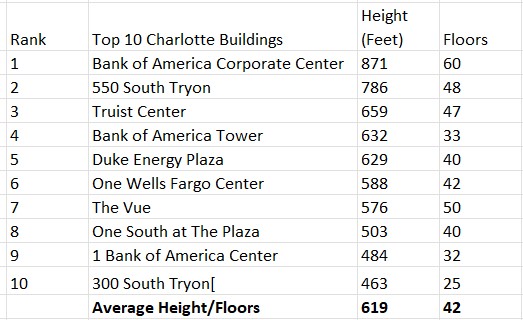
Data source – Skyscraperpage.com
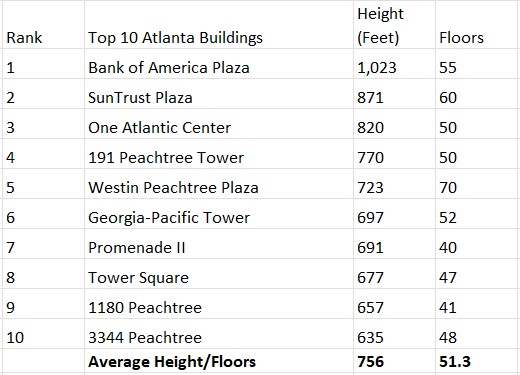
Data source – Skyscraperpage.com
I combined the top ten tallest buildings in both cities (20 total) in a mash-up to see how they would rank side-by-side. In the top half, eight are in Atlanta, and eight of the bottom ten are in Charlotte.
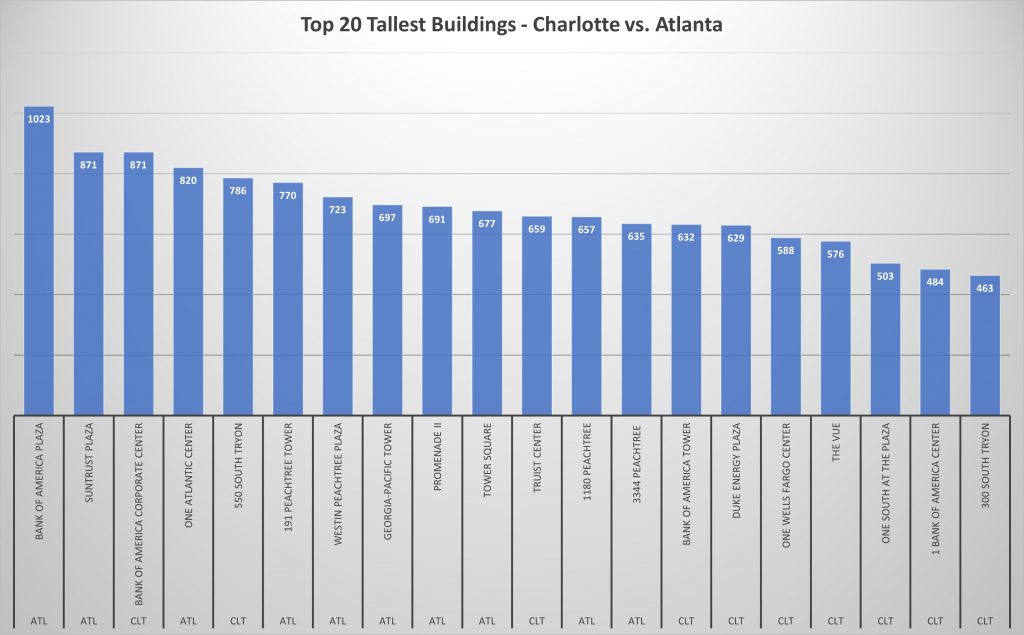
Can Charlotte Catch Up or Pass Atlanta?
Charlotte is a rapidly growing city (mainly through annexations) and metro area. The only other major sunbelt city that it can be compared to in terms of growth is Atlanta. This makes it easy for many to call it the ‘next Atlanta’, or ‘baby Atlanta.’ Atlanta has seemingly welcomed growth ‘at all costs’, wherein Charlotte leaders seemed to have been more deliberate (controlled sprawl?) in how Charlotte grows. The big question is will Charlotte ever catch up to or pass Atlanta in metro population, public transit infrastructure, and skyline size and density?

Great article! As an Atlanta native, I miss the old Atlanta. I’m considering moving to Charlotte at this point. And recently learning that Charlotte is a tech hub, I think this is confirmation for my move. If anyone can offer suggestions on racially diverse neighborhoods, I would greatly appreciate your input.
Thank you! Just curious when you say that you miss the old Atlanta, what are the things you miss about it? I’m glad that my article helped you make a decision on moving to Charlotte. I don’t know much about the diversity of Charlotte neighborhoods and which ones are the most diverse. I found this Niche ranking and hope it can be a good start on helping you. https://www.niche.com/places-to-live/search/most-diverse-neighborhoods/m/charlotte-metro-area/
I’ve been to both, however, l currently live in Charlotte. It has more of a northern feel, more inclusive diversity and a larger household income base. If you have a college degree, your chances of creating the lifestyle that you’re looking for is there in the Queen City
Hey I’m born and raised in Charlotte. And I just moved to the Atlanta area. Charlotte is much better it’s cleaner bigger and it’s still growing. Try the hunterville area
Charlotte is not bigger than Atlanta – read the article.
CLT is bigger… regarding city population and land mass area; read the article.
Read the article again. The metro population is more than double the size of Charlotte. Charlotte is NOT bigger than Atlanta. Atlanta has over 6 million people, Charlotte still has cracked 3 million.
Charlotte,North Carolina is 921 thousand people 420 thousand more people than Atlanta.
Agree Huntersville area is nice but it’s not Charlotte. I live in Cornelius now after living in city of Atlanta for over 40 years. Will Charlotte ever have a mass transit system, trains at the airport, beautiful covered stadium, off the chart baseball stadium, historic Fox theatre, 2 top notch universities. To me it is easy to compare but frankly, Charlotte is missing soooo much. Atlanta is thriving and growing faster than ever.
Charlotte does have a mass transit system. light rail with 43 stationsm
In my experience and travels, having lived in Atlanta and Raleigh and traveled repeatedly for trade shows to Charlotte, NYC, Dallas and abroad:
Charlotte-Dallas or Nashville on a small scale
Atlanta- Houston or for sure without the Gulf
Raleigh-Durham- More like a small Austin in sensibility and emergence
Hi Teresa, thank you for reading this and your insight! You’ve made me think about a Raleigh-Durham and Austin matchup. Although the central city of Austin is a little less than 1 million in population, the metro areas are a little closer, with the Austin metro area about 200K larger than the Research Triangle area. Thanks for the inspiration, Teresa!
I live in city of Charlotte walking distance to downtown and have lived in Atlanta as well .I perfer Atlanta cause the city offers so much more to and great light rail . Charlotte has a long way to catch up with big ATL .Charlotte doesn’t even have a zoo and there is little to do except go to restaurants and a few malls . We are very bored here and drive often to Atlanta for things to do
Great article! Atlanta is an amazing city, I always love visiting. There are a lot of great reasons to move to Charlotte based on some of the commenters here! https://www.uphomes.com/blog/moving-to-charlotte-nc.html
I am getting into this argument fairly late, but I want to note two things IF you haven’t already written your new comparison argument. One is historical-In 1930 Atlanta’s population was 270,366, Charlotte was 82,675. Charlotte really didn’t begin to take off until the airport became a hub for Piedmont, then USAir and now American. You could make the same argument for Atlanta, only the hub came even earlier and with a ‘slightly’ larger major airline- which I believe still is true today. Secondly, and I must state I grew up in Charlotte, the Charlotte-Raleigh comparison has to be approached from a different POV than suggested by some. Raleigh(as state capital) is probably the most important city in North Carolina. However, Charlotte’s location (and the growth of towns like Rock Hill, York, etc. plus the location in the middle between two capitals Columbia is even closer than Raleigh-leads Charlotte to be the most important in the Carolinas (and explains why the Panthers chose to be the Carolina Panthers, not North Carolina Panthers:) If you do another article, you will need to consider how Charlotte is destined to be the metro focus for two states, not one.
This two-state comparison is just one of the things in which I think separates Charlotte from Atlanta. Atlanta is a very condensed area in terms of a metro in Georgia and when you leave the Atlanta area, Georgia becomes a lot more rural than N.C. Atlanta has well been referred to as the Capital City of the South, in which I think is fitting for the city. Charlotte’s location on the SC border most definitely includes a lot bigger population than will be revealed. Refer to Carolina Panthers. But the real kicker is what happens when you leave the Atlanta area. Actually, this is where Charlotte trumps Atlanta. Not far away is Asheville. There is no place in Georgia that can compare to Asheville. Next, you go not far East and you run into the Research Triangle area. This is the equivalent of having two Charlottes vs one Atlanta because of the population density that exist between the two areas on the short drive.
I was with you until you stated the research triangle area was like two Charlotte’s. That is not accurate.
Asheville is a total dump and Atlanta is closer to several beautiful mountain towns and less than 4 hours to Savannah and Florida. You can’t say Atlanta doesn’t have a better location.
I was just in Charlotte a month ago. These arguments have been going on for years. Charlotte by sq. miles is much larger than Manhattan, but the metropolitan sprawl and population makes Charlotte look like sprayberry. Im from Atlanta and I can tell you that Charlotte is country compred to Atlanta
I did not know there was a rivalry. I have been in Atlanta for over ten years now and every now and then I will see an article like this, but it comes from outside of Georgia.
I wanted a big city experience after leaving L.A. Atlanta is really your only option. You will live and work with people from all over the world. There are endless neighborhoods to explore and of course top rate shopping and cheap direct access to most places bc of Delta and Hartsfield.
Who cares? Charlotte is Charlotte and ATL is ATL. There as pros and cons to living in either city. However, it is true that Charlotte is demographically and geographically much larger than ATL proper. Overall, ATL has much more to offer than Charlotte. Nonetheless, I believe once the rail system extends to the airport, more opportunities will open up for the city of CLT and, at some point in the distant future, it will be just as highly respected as ATL. BTW, while ATL may be closer to San Fran in many respects, it will never be in that league.
Obviously you care. I think it’s going to be a very long time before Charlotte catches up with Atlanta. It’s just a way different vibe. Atlanta has one of the highest population of LBGT in the country. Something just just won’t ever happen in Charlotte. Once again it’s the vibe. ATL has a large black population, for which we take great pride. Atlanta and metro Atlanta has a huge immigration population. Simple drive through Gwinnett county and one can see street and business signs in both English and Korean. Clarkston has a large refugee population. Any country where there has been conflict in the last 20 years+ is represented in Clarkston. That tiny town has been called the Ellis Island of the South. But back to Atlanta itself. I think three simple things set ATL apart from CLT. Public transport, CTL is so large an automobile is practically required. The Airport and finally. It’s dozens of neighborhoods. Sure everyone knows the big three Downtown, Midtown and Buckhead, each with connecting skylines, but East Atlanta, Reynoldstown, Cabbagetown, and on and on. One could easily live work and play without ever leaving their own neighborhood. I don’t think Charlotte will ever be that way.
Ehh Atl has been taken over by hood rats . I wouldnt dare live in Atlanta can not leave a tooth brush in your car they will break into it .
ATL is a cesspool of violence, weird progressive liberals, and poverty on the levels of NYC. Charlotte is more rarefied, rooted, and a way better location near mountains and beaches. NC as a state is better than GA. RDU is better than ATL in regards too quality of living as well. I travel all over the US for work, ATL has to be one of the worst cities in the country..
And the comment above, while it says one things, also says another about what separates the two cities. All the above is missing is a racial slur or a crack about immigrants.
Atlanta is full of all kinds of different people, cohabitating and making a go at life. You don’t need to be concerned about not finding a community of people like yourself, no matter that be from the U.S. or another country. Atlanta is a global city with global vibes.
And the crime thing is a myth. Violent crime is dramatically down across the Atlanta metro. Atlanta is not even in the top 15 for crime. This only requires a simple Google search. Resorting to misinformation in an attempt to make your point stick only weakens the argument that you are intellectually honest.
I agree that they get the crime stats wrong about Atlanta. I live in a part of DeKalb County that is not supposed to be a great area, but we’ve been in this area since 2013, and it’s been great.
Charlotte and Atlanta’s demographics are actually quite similar, both Majority-Minority cities, Charlotte’s government is almost entirely run by black residents, and now Charlotte’s population is nearly 20% immigrants.
They’re quite similar with how they’ve sprawled, just Atlanta has sprawled more because there’s more people there, you can stay in one neighborhood in the Charlotte-Area without having to leave, often that’s what happens. There’s several in Central Charlotte that have their own identities such as Uptown, Southend, NoDa, Elizabeth, Dilworth, Plaza Midwood, etc….
“The cities couldn’t be more different in density”? Seriously? 3000 vs. 3500?
Also, look at the MSA’s — those densities couldn’t be more different. The Atlanta, GA MSA density is 708; the Charlotte MSA is 889. I guess, according to the person who replied would have to say that Charlotte’s MSA density is much higher and the MSA’s couldn’t be more different, i.e. the Atlanta, GA MSA is sprawl central. (PS the CSA is even more dismal for Atlanta, GA). Just saying…
PS no one in Charlotte or anywhere but Georgia would refer to Charlotte as “baby Atlanta”. Repeat…there’s no place on the planet outside of Georgia that wants to be like Atlanta. WE get it, you’re egos eclipse all others and you are champion bloviators, but y’all are delusional.
Mack,
Here’s a 2014 article from the Charlotte Business Journal referencing another article about Charlotte being the ‘new Atlanta.’ I’m sure many in Charlotte agrees with you, but there are many that don’t. https://www.bizjournals.com/charlotte/blog/morning-edition/2014/10/is-charlotte-the-new-atlanta.html
This is a nice, informative article, but it seems a lot of people are maybe reading too much into the info given. Comparing one city to another does not necessarily imply that one wants to be like the other, it’s just a data comparison. You could compare Atlanta to LA or New York, but that doesn’t mean Atlanta wants to be like them (and I believe most of the populace would agree). Each city develops its own personality that remains unique even among cities of the same size.
I lived in and around the Atlanta metro area for 40 years, and my wife was a 3rd generation Atlantan. I would say we had a pretty good feel for the city and people. We recently moved to the Charlotte area for work and both commented how the area felt like Atlanta did 30 years ago. It’s kind of hard to put words to it, but I guess you could say we felt Charlotte is more ‘relaxed’, and the people seem a bit more accepting and friendly.
Anyway, keep up the good writing.
great comment, clt is still more spread out and has more of the southern hospitality feel regardless of population and size. But Atlanta gets more transplants from Philly, New York, and even LA also more foreigners the reason they have the bigger city vibe. I guess it depends on what you’re looking for!
There is one more clear distinction between Atlanta and Charlotte. Atlanta is far more welcoming a city. While Charlotte is so huge, it still has an old south clannish mentality. Old money looks down on new money. Locals hold onto old social ways of thinking and Atlanta offers far more opportunities for a greater portion of its population.
Charlotte can keep NASCAR and have all the banks and bankers it can hold. NASCAR events are riddled with confederate flags and bankers are boring.
That could not be any further from reality. Charlotte is very welcoming, especially toward new money. Where Charlotte has a problem is its willingness to tear anything down linking it to the old South for the almighty dollar. I could only wish Charlotte would have clung on to its old social way of thinking. As for NASCAR, no one here cares. NASCAR killed itself by trying to take the South out of the sport. It doesn’t matter whether you’re in Georgia or Virginia, NASCAR destroyed itself.
So it’s not a liberal cesspool of weirdness and people throwing their WOKENESS at you? Sounds good too me.
I think it’s ridiculous to refer to Charlotte as “baby Atlanta”. That’s such an insult. Why would Charlotte even strive to be like Atlanta? Also someone implied that Atlanta would be more comparable to San Francisco than Charlotte is to Atlanta. That’s utterly ridiculous. I lived in San Francisco in the 70s and Atlanta’s still doesn’t have the level of sophistication that city had back then. I do love Atlanta, however, but it’s not San Fran, and definitely not NYC, where I lived for many years before moving to CLT 10 years ago.
I agree. Charlotte is not a baby ATL. It has more population.
As a well traveled professional and rental property owner, I must say Atlanta has dramatically morphed into something even I did not expect. It is nothing short of incredible and it seems this last cycle really pushed the city to a new level. Viewing Downtown, Midtown, Buckhead and Perimeter Center all at once from the south looking north shows the vast, maturing cores that have thickened greatly over the past 15 years. The Midtown, Perimeter and Buckhead skylines have reinvented themselves. Atlanta has always led the Southeast since I have been around, but the metro has now moved into the top 6, leapfrogging Washington, DC and Philadelphia. I understand Atlanta and Charlotte, at one time, were direct competitors, but in 2024, Charlotte and Atlanta are not in the same national or international leagues. Atlanta is competing with Dallas and Houston. Charlotte and Nashville will do well, but the momentum in Atlanta is that of a top 10 metro. Having said that, investors cannot go wrong in any of the Southern cities I have mentioned.
I’m born and raised in Charlotte. Been to Atlanta a 100 times. Been to Lithonia, Douglasville all the cities Stone Mt all of them. My son lived in Lithia Springs for 3 yrs. My ex was Franklin Ga. Believe me when I tell you Atlanta does not compare in size to Charlotte. It’s not even close. Charlotte takes about an hour to get around the whole city and that’s riding on I-485 outbelt. Atlanta has more metropolitan area but the city itself is relatively small compared to Charlotte. I was actually shocked how fast we rode through the city to visit my son in Lithia Springs. It was a blur. These are the facts.
Anthony, you are correct in saying that Charlotte’s city limits are larger than Atlanta’s in size (square mileage). While the 485 Outerbelt is about the same mileage as Atlanta’s 285 perimeter, 285 is much more developed on most of it, compared to 485.
I can agree that going from east to west, Atlanta is not as impressive. Going from south to north or vice versa is a different story. Fulton County (where much of Atlanta sits, is 70 miles long, with almost 1.08 million people. There’s steady office and retail developments from Alpharetta to interstate 20. With okay traffic (which is any time after 8 or 9 pm), it takes about 30 minutes to go the 26 miles from Alpharetta to downtown, a distance greater than from uptown Charlotte to Rock Hill. Here is a Reddit thread on Atlanta’s many skylines. (https://www.reddit.com/r/skylineporn/comments/1bodqf3/the_many_skylines_of_atlanta/)
The buildings in the foreground are in Sandy Springs, a city that is about 9 miles from Buckhead, (the next clump of buildings in the image). The buildings farther out are in midtown and downtown (about 14 to 16 miles away from Sandy Springs). The population of the area in the photo is about 617,000.
This article is very accurate. There is no comparison between Charlotte and Atlanta. Atlanta is a global city, with Fortune 500 Companies and the Hartsfield-Jackson Atlanta International Airport. Charlotte is simply an aspiring city that wishes to grow to the likes of Atlanta. That’s not to imply Charlotte is a bad city. It just needs to get it’s own identity, and stop comparing itself to the likes of Atlanta, and even Raleigh.
Thank you! I agree, there’s no comparison between Charlotte and Atlanta. They are separated by millions of people, pace of life and skyline density.
When does Charlotte ever compare itself to the much smaller Raleigh. It’s also twice the size of the city of Atlanta and more content with being a true southern city rather than a wannabe southern NYC like Atlanta.
I am a true Charlotteean and we would never compare ourselves to Raleigh. Charlotte is the NYC of NC that is not even a contest. I’ve been here in Charlotte 41 years.
When people compare cities and metros, they often make the comparison over a very small span of time of 20-30 years. Is that an accurate analysis? Cities and metros may be at different stages of their development during that 20 years; consequently, they may not compare well during that time frame. For example, the Atlanta metro population during the 1960s and 1970s was less than 2.0 million and much smaller than Philadelphia’s metro. Philadelphians probably looked down on Atlantas critically during that era. But Atlanta’s metro population today is right there with Philadelphia’s. I traveled to Atlanta very often during the 1980s and 1990s. Atlanta in the late 1980s is very similar to present-day Charlotte. I really liked Atlanta during that time-frame, and I really like Charlotte today. Everybody knows that Atlanta is much larger than Charlotte today so I am not exactly sure why anyone would feel it necessary to make the comparison. On sheer size, Atlanta wins hands-down, but quality of living is a different story.
Charlotte is not trying to be Atlanta. Why should it? I would not live here if Charlotte was like Atlanta.
excuse me Charlotte is my Home, Born and Raised. who in Hell told you we want to be like atlanta? did you READ the article We’re BIGGER & BETTER.
Charlotte does not aspire to be Atlanta, GA. No city aspires to be like Atlanta. It’s a disaster.
Atlanta, Ga.Will Be Always A First Class City With Charlotte,N.C.Atlanta Has Great Transit System.Than Charlotte’s System.Also Great Skyscrapers,And Five Major Sports Team.09-12-2021 Time Sent 2:54
Charlotte is way bigger than ATL. And it’s only getting bigger.
Charlotte is very comparable to Atlanta. It is the largest city in the south outside of Jacksonville FL. Bit FL is not considered the south.
I’m not sure about Charlotte comparing itself to Raleigh. Charlotte is a true southern city, it’s in a southern state, just as Atlanta is. Southern cities with ‘traditional southern culture are more reserved for Charleston and Savannah. Charlotte has many northern transplants (like Atlanta and any other fast-growing southern city). I agree that Charlotte may be more family-friendly and slower-paced than Atlanta, but it’s roughly where Atlanta was in the 70s in terms of size and regional importance. Atlanta is not an NYC wannabe, it’s a city that has attracted tons of people (admittedly, many from NYC, investment, business for much of its existence.
Did ya read the article? Atlanta is far more densely populated than Charlotte and has less than half the number of high rises per square mile. Charlotte has benefitted from incorporating unincorporated land around the city – giving it an overly inflated population figure that doesn’t really match the rest of the city’s attributes.
Ari,
I have come across this rather randomly. However I wanted to say, very good article. Well put together.
In a former life I have been a city manager, county official, and involved with business development districts and urban planning. In my current role I am an executive with a firm that evaluates real estate in all 3,100+ counties in America and travel some 50 plus cities a year. I have lived in NYC and NC for extended periods over a decade each. All that said merely to highlight the educated perspective to say in which I enjoyed your piece.
You were apt to draw the important distinction between metro data to municipal limit data.
You fairly noted on the front end you were not looking at quality of life (QL) metrics. However, certainly there are some impact from core data points and standard qualitiy of stats on one another. Traffic, education, cost of living and more are standard QL metrics.
The higher income in Charlotte and higher poverty in ATL are contributing factors for greater demand in public transportation.
Thus one would expect MARTA to have higher ridership and great infrastructure because of demand.
Likewise poverty impacts education stats and the degree to which a city has a highly educated workforce impacts poverty. And so on.
Another key impact to consider is the diversification of the economy. Here ALT clearly wins. In fact, there was some notation of a Charlotte Raleigh comparison, and there Raleigh early wins.
It is surprising to see one of the comments suggest offense at the Raleigh Charlotte comparison while trying to compare Charlotte to ATL. More surprisingly because it is talked about a lot in NC. I have personally been a speaker at community events in all 100 counties in NC….it is talked about.
Raleigh is certainly smaller in municipal population but not that much smaller in metro. In government, media and other key industries the Top 50 metros are standard among targets and benchmark data points. Raleigh and Charlotte both fall in that area. Raleigh is in Wake County and a couple of years ago it surpassed Charlotte’s Mecklenburg county for largest in the state. The Wake School system surpassed Meck schools for largest in the state a decade ago. Raleigh is physically bordered by Durham and Cary; whose additional 2019 Census estimate population combined would surpass Charlotte. On those new estimate numbers you are talking a designated statistically defined metro of nearly 2.5m in Charlotte vs 2.1 in The Traingle – a far closer comparison than the nearly 6m in ATL.
The key point being it is probably a more appropriate comparison than ATL and Charlotte. Now I make no knock on my froends in Raleigh or my friends in Charlotte.
In such comparison certainly Charlotte feels more cosmopolitan and denser as more of it’s core is in that uptown city center.
While in the Triangle, as the metro is known, is spread out a little more. Tens of thousands of jobs in Research Triangle Park (RTP considered by many the Silicone Valley of the East Coast) stradles the municipal borders of Raleigh, Durham, and Cary. Heck even the airport RDU is physically on both sides of the municipal line. Along with RTP in such close proximity is downtown Durham with thousands who work in education and medicine at Duke, and a downtown Raleigh with thousands who work in government as a capital city, education at NC State, and so much more.
The Triangle certainly has more museums which is typically a key metric of culture, but to be fair it is because Raleigh is a State Capital and host the “State” everything….state art museum, state history museum, state science museum, state fair and so on.
Raleigh has greater percent of population with advanced education and likely why a higher median income. With that Raleigh has a lower poverty rate. Charlotte typically wins on public transportation but again Raleigh has less demand with a decentralized workforce and lower poverty. This drives different infrastructure needs. Raleigh is completing its second major betline while Charlotte has yet to finish their one.
The economic diversity of the Triangle is one reason it was considered the last one in and first one out of the Top 50 metros during the great recession 12yrs ago. Tech, education, healthcare, state government jobs and more add to the diversity. Likewise with Charlotte being so heavy in banking they were one of the early ones in.
On and on this could go, and again taking nothing from all the wonderful things in Charlotte, but Raleigh Charlotte is a much more realistic comparison than Charlotte Atlanta.
NC and GA are both beautiful place and these three cities have anchored big growth that has pushed both states into the TOP 10 in US by population bumping out NJ and pushing back Michigan. They are within a hair of each other on this chart with 10.6m for GA and 10.4m for NC. Both should likely pass Ohio at number 7 by 2030.
Meanwhile while maybe a little more geographically and culturally further apart from ATL, Dallas or Houston would be a better comparative metro than Charlotte based on size and may merit one of your good comparisons.
Thank you John for reading my article and your knowledgeable comments. I’ve learned much from your comments, namely that Raleigh is close to Charlotte in population and has more amenities. I agree with your analysis that a Charlotte and Raleigh comparison article would be a better piece. You are also accurate about Atlanta being in the Dallas and Houston category, and thus warrants a comparison article. I actually wrote a similar Atlanta vs Houston article. For some reason many readers like to compare Charlotte and Atlanta. It might be derived from seeing done physical and infrastructural similarities and doing the ‘mental exercises’ in making a comparison. Whatever the reason, when looking at my analytics, the terms ‘Charlotte vs Atlanta’ ranks high. Thank you John, for inspiring me to write a Charlotte vs Raleigh article. I will consider adding more quality of life metrics in addition to the poverty, median household income, and public transit data. Perhaps a museums per 100k, park acreage per 100k would be a great start.
Sounds great. Looking forward to reading more of your pieces. All the best.
Interestingly enough, the reason I came across your article was a Charlotte newspaper headline this week touting how Charlotte has now past San Francisco for the 15th biggest city in America. This was in city limit population and the comparison’s were laughable.
Anyone who understands urban planning and analysis knows the extent to which large US urban areas are a hub for a broader metro region. Metro population is what drives demand for infrastructure, amenities, and more.
Even moreso now regional planning takes in account CSAs Combined Statistical Areas which expands metro counts out a little further to their true regional reach.
If there is no Atlanta driving economic activity, infrastructure, an international Airport then Alpharetta would still be a corn field with one stop sign.
Comparison of Charlotte to the SF CSA or the “Bay Area” is almost pointless. The Bay area CSA is huge. Again, unlike Charlotte, Atlanta would be a much better comparison to SF, although culturally they trully are worlds away.
Wow. There is no comparison between SF and Charlotte. I see the boosters are still focusing on the city limit population. I agree with you on how the MSA (and the broader CSA is truly considered more so than what’s in the city proper. I wouldn’t be surprised if Charlotte’s leaders are not floating the idea of consolidating with Mecklenberg County (minus the five other cities). It’s great to discuss all of this with someone well-versed in this subject matter. Thank you again for reading my articles.
You may not be aware, but the state of NC changed the law in 2012 making it much more difficult to almost impossible for cities to annex. Yet, the City of Charlotte is adding around 15,000 new residents annually without annexation. This is being driven by infill and apartment growth. Much of this apartment growth is along the Blue Line. The 3 miles south of downtown from I-277 Belk Frwy to Woodlawn Road (South End) had more apartments built over last 10 years than any section of any city in the US. The Blue Line North just opened in 2018, and now the apartment construction has begun in earnest while the South End construction continues.
Who knows if Charlotte will ever catch Atlanta in population. In fact, it probably won’t. If traffic and other negatives slow Atlanta’s growth, it may then be possible. I do think for many years Charlotte was enamored with Atlanta. But those days are over. Charlotte has grown up and no longer desires to be like Atlanta. Charlotte now feels confident to be its own city. But this is not to say that Charlotte will not someday become much like present-day Atlanta. Time will tell on that subject. But Charlotte hopes to learn from Atlanta’s mistakes. But i see Charlotte making many of the same mistakes as Atlanta, unfortunately.
For those Atlantans considering Charlotte, I see many license plates from metro Atlanta around the Charlotte area now. Charlotte housing is pretty diversified, but northeast Charlotte would be the most diversified.
I wasn’t aware that the state of NC changed their liberal annexation laws. Thank you for bringing that to my attention. I believe you when you say that Charlotte has added a lot of infill and apartment development. The city is totally different from when I visited there often in the 70s through the 90s.
I looked at population data for both cities. Between 1990 and 2010, the city of Charlotte grew 13 times more than the city of Atlanta (16,775 people added each year versus 1,299 each year for the city of Atlanta). Atlanta, however, was the growth per year champ when looking between 1850 and 1990 (3,723 per year vs 2,820 per year or 1.32 times more).
When adding all census figures between 1850 and 2010, Charlotte is the winner for the number of residents added each year: 4,565 vs 2,609 for Atlanta or 1.75 times more.
I infer from this that Charlotte benefitted more from liberal annexation laws rather than organic growth. Between 1850 and 1990, Atlanta grew an average of 65.87% each decade, while Charlotte grew 55.14%. Charlotte city population took off between 1990 and 2010 and it’s most likely due to annexations. You can see the data at https://drive.google.com/file/d/161fheIfFKEks5_8FMT2IZrFKtkc9iOs2/view?usp=sharing
Whew! Your post had a few strong opioins there! That’s O.K. because that’s something that I like to do sometimes too. I have heard of the annex law that Charlotte passed back in 2012 correct me if I am wrong but that might have been the law that made it possible for Charlotte to stop annexing land for the city limits itself and to start building the suburbs so it will have just as big suburban population someday that both Atlanta and where I live the D.C. area the DMV someday something that hasn’t happened in Charlotte yet for a very long period of time. As far as what you have posted about Charlotte compared with Atlanta when it comes to population growth and mistakes though some of what you have said is not accurate. Who knows if Charlotte will ever catch Atlanta in population? LOL Charlotte’s population is bigger than Atlanta’s! Charlotte is also bigger as far as square miles go. Charlotte has never desired to be like Atlanta! If you aren’t sure about this fact just go to Charlotte and ask some of it’s residents! Have you heard about the Odell Plan? That’s the plan that was implimented in Charlotte for the poupose of making sure Charlotte doesn’t make the same mistakes Atlanta has when it comes to things like urban spawl. Something that has happened in Atlanta too much which has caused some of Atlanta’s problems. In fact Atlanta is the city that has spwaled more than any other city in the world! Charlotte will become more like present day Atlanta someday when it comes to things like diversity. Charlotte’s diversity is a lot better today then it was in the past. When it comes to things like crime,spawl,traffic etc. I hope not! The Ordell Plan, Charlotte proposes a new Ordell Plan every 20 years, is one of the things I think will make sure of that. What makes you think Charlotte’s housing is pretty diversified? It isn’t at least not now. So it’s good to know Charlotte’s housing in the future will be more diversified in the future at least in the north east part of the city.
you dont read, do you?
The “article” was written by Atlanta, GA boosters.
“The cities couldn’t be more different in density”? Seriously? 3000 vs. 3500?
Also, look at the MSA’s — those densities couldn’t be more different. The Atlanta, GA MSA density is 708; the Charlotte MSA is 889. I guess, according to the person who replied would have to say that Charlotte’s MSA density is much higher and the MSA’s couldn’t be more different, i.e. the Atlanta, GA MSA is sprawl central. (PS the CSA is even more dismal for Atlanta, GA). Just saying…
I want to make one last comment. MSA population is the standard. When comparing ATL to CLT, I use MSA population. So, yes ATL is much larger. CLT’s MSA population is 2.7 million or about the size of ATL in mid to late 1980s. The difference in density in comparing CLT to ATL is minimal when considering city or MSA density. ATL is a major economic force so CLT is not really comparable to ATL. CLT is the size of ATL in the 1980s.
Last thing is the guy from Raleigh was wrong about some things as usual. You can look up and verify my info. The CLT CSA is 2.9 million compared to the Raleigh-Durham-Cary CSA population of 2.1 million. Do a Google search for each CSA on census reporter. The Raleigh -Durham-Cary CSA is growing at a slightly higher growth rate percentage, but the CLT CSA added 60k more people than the Ral-Dur-Cary CSA between 2010 and 2020. Anyone that is a serious student of population data would know this. The CLT MSA and CSA are consistently ranked between fifth and ninth in the US among all metros in absolute population growth. The Raleigh -Dur-Cary CSA does not rank in the top 10 in absolute population growth. CLT is much more diversified than a banking center. Nine of the 13 Fortune 500 companies in NC are based in CLT area and 17 of the Fortune 1000 companies in NC are in the CLT area. The bottom line is that CLT is significantly larger than the Triangle and adding more people. CLT’s urban core is much larger and more dense than Raleigh’s. DT Raleigh only has 48k employees compared to DT CLT’s 120k.
I traveled to ATL a lot in the 1980s and 1990s. CLT today reminds me a great deal of ATL in the 1980s. CLT’s traffic congestion is growing rapidly and is comparable to ATL in the late 1980s. CLT must try to figure out how it can in the future avoid the traffic congestion of present day ATL.
The ‘article’ was written by someone who lives in Atlanta, and who has a solid history in Charlotte, and loves Charlotte. It’s not meant to boost either city, but to compare both and answer questions many online searchers are asking.
David, I agree with your points. I was motivated to compare Atlanta and Charlotte for the same reason I wrote an article comparing Atlanta and New York City: there are an enormous amount of search queries asking these questions.
There are many in Charlotte that are fiercely anti-Atlanta. There are many in Atlanta considering moving to a smaller Sunbelt city and Charlotte is mentioned alot as a ‘baby Atlanta’, with better quality of life. There are many people moving from other parts of the country that are considering both cities because they come up in a lot of search queries.
We know that comparing the two, like comparing Atlanta and New York City are an apples to oranges comparison, but there are many considering moving to the southeast that don’t know much about either one outside of a Google search.
Thank you for your great points.
Great statement, I study southern cities and the two have had very different paths of growth. Charlotte was settled in the 1750’s and remained under 1,000 population until the 1850’s, 1900 it was just 14,000. Charlotte only became big during it’s evolvement during both world wars, putting it at 100,000 right before the second, and reaching 200,000 in the 50’s. Atlanta started getting people right when it was settled in the 1830’s because of the railroads which Charlotte didn’t have at the time. Atlanta got it’s first 100,000 shortly after the turn of the 20th century and broke 200,000 by 1920, when Charlotte’s population was trying to reach for 40,000.
They are both changing tremendously in this time we are in, the transformation in Charlotte is much more dramatic because it’s just now reaching it’s maturity as one of the countries largest cities, which is an extremely recent and ongoing development. Just to give a few examples of major projects underway in the city; $3 billion airport expansion, new $100 million main library, new $100 million downtown Amtrak station, $13.5 billion tranist plan including about 70 miles of additional rail, and several billion dollars in active development in the central business district. There’s several transformative proposals as well such as a 220 acre central park adjacent to the business district. It has been very exciting trying to keep up with everything going on there. To conclude, this is why I agree with your statement, they are different cities that grew at different times and different paces, both growing very fast right now because of the population shift to the southeast and are both considered very affordable by national standards. Because Atlanta got big earlier, it’s more matured, while Charlotte appears to be going through puberty.
wrong bro you must of not read the article Charlotte is almost twice the size, but Atlanta is more dense you can also Google that. Atlanta has a bigger city vibe because they have alot of northern transplants and LA influence and the Rap music and movie influence, but Charlotte is definitely bigger population and land wise.
You know what you don’t find in Atlanta? Anti-Charlotters. Seriously. I have been here for a little over 15 years and not once has anyone here even brought Charlotte up in conversation except a few have mentioned they enjoyed a visit there. I don’t think Atlantans are even thinking about Charlotte. Everybody I know and work with is focused on taking full advantage of opportunities from the growth and money flowing through the city.
This “rivalry” seems one-sided and quite transparent…these feelings of inadequacy based on the size of the city you live in is a topic for your therapists.
I like the perspectives. I enjoy reading the data all in one place and from reputable sources.
You’re right, Atlantans don’t bring up Charlotte in a rivalry sense. Occasionally you’ll hear someone say they are thinking about moving to Charlotte, or just moved back from Charlotte. I have a good friend that moved back from Charlotte earlier this year after living there for three years. She hated it and talked about how different the cities are.
Right? If all cities were like Atlanta, or NYC, or a san Fran then no one would like to live in them. Sure, they have lots to offer, but quality of life is impossible to sustain in those kinds of cities
Here’s a 2014 article from the Charlotte Business Journal referencing another article about Charlotte being the ‘new Atlanta.’ I’m sure many in Charlotte agrees with you, but there are many that don’t. https://www.bizjournals.com/charlotte/blog/morning-edition/2014/10/is-charlotte-the-new-atlanta.html